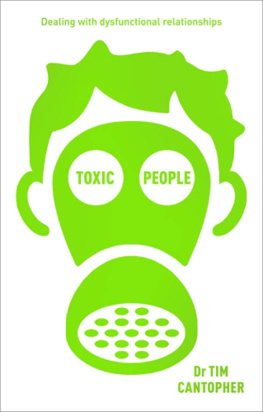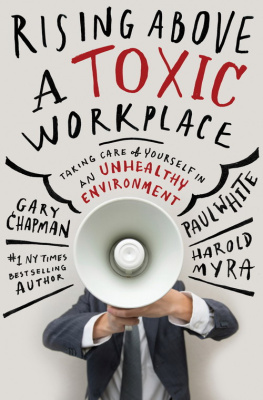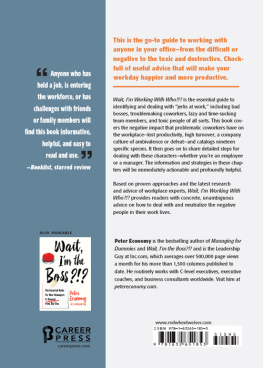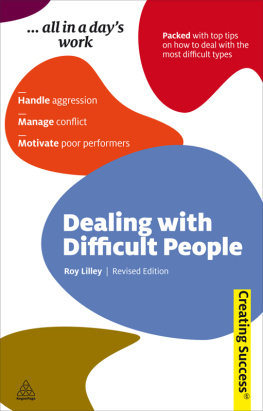Chapter 10 - Plotting Toxic Cleanup
Why is it that you can always think of the right thing to say after a difficult communication? Because you dont use what you know! VIP (very important plotting: verbiage, intent, and posture) communication tells you to put your mind in gear before opening your mouth.
You know this; you just dont always do it! Understanding how to communicate more effectively is no guarantee that your interactions will automatically improve. Understanding is one thing, whereas achieving a different outcome is another. You have to practice new behaviors over and over to develop a habit. This is just as true for verbal skills as it is for any others.
Habits for VIP Communication
If you want to move into the upper echelon of VIP communicators, you will have to create habits built on what you already know: verbiage, intent, and posture. The fact that you have seen other people manage fights, angry people, and toxic situations proves that these are learnable skills. If you cant deal with Toxic People now, its not that it cant be done; its just that you have not yet chosen to learn and polish your skills to get it done.
VERBIAGE
Think of the words that send you into orbit. For me, the phrase Do you understand? has a very negative connotation. Do they think Im stupid? is whats going through my head when I hear that phrase.
For many people, such comments feel like a verbal slap in the face.
Have you had this experience, too? If so, do you ever find yourself doing the same to other people? Why? Eliminate such words today and instead choose to say something like, I want to make sure I was clear. Can you please play that back in your own words?
Always give others a reason for listening to you. Choose words that benefit them. VIP conversation should be less about you and more about the other party. Keep in mind that good judgment comes from experience, and much experience comes from bad judgment.
INTENT
Approach toxic situations with positive intent and eliminate the focus of getting them before they get you. Results improve when you anticipate meeting others with a positive intent that focuses on everyones desired outcomes. Another critical issue is keeping a positive attitude about what you are capable of saying. You can do this by filling your mind and mental toolbox with affirmations such as: I have practiced this scenario and understand the words that will ultimately get the best results.
Eliminate all thoughts and visions of a negative outcome when you plan your encounters. Why? Because what you think will influence how you come across to others. People are smart and clever. They can see right through a phony attempt to meet their needs. In addition, positive intent gives you power and control, and isnt that what you ultimately want?
A seeming contradiction to being proactive is the strategy of just letting go. Your intent may be to resolve the situation, but occasionally, in your heart, you know it will never work. You must have a well-developed sense of self-awareness to walk away and know it is the right thing to do. No matter how good your skills or what your intent may be, you will never resolve every situation. Whether it is a boss, a colleague, or a subordinate, there are just some relationships that are not going to work. They should be a small minorityless than 2 percent. And make sure you do not take these irresolvable conversations, situations, or relationships personally. Reaffirm your own thinking process by being sure you do evaluate the situation to figure out what you might have done differently, in order to increase your skills for future encounters.
POSTURE
Eliminate emotional posturing and closed body language.
Crossed arms, furrowed brow, intense glare, and no smile are physical communication signals indicating that trouble lies ahead. You know you shouldnt be doing things like this when working on improving communications. You subconsciously use them because they have become habits. Train yourself to stand with your arms uncrossed, lean forward, push the energy toward the other person, and keep a pleasant, non-threatening look on your face.
Start watching the posturing of others by observing their energy levels. Then when you do have a toxic situation, you are one step ahead. Do they express their thoughts and emphasize their points by using their bodies and gestures? Or are they more reserved physically? They may have a natural drive to conserve energy. These differences are noticeable in group situations, because energetic people gain momentum within a crowd. In contrast, less energetic individuals are drained, causing them to become withdrawn. You can apply this energy observation when approaching Toxic People by matching your energy level to theirs. Remember, your control of the situation comes from watching and waiting.
Watch for animation, or lack of it, in their facial expressions.
People who are real thinkers are not facially expressive in general.
This means my posturing and body language with them will be less animated. The other side of this is to watch for physical expressions such as pulling a chair closer during a discussion, leaning toward or away from you, or pushing documents to the side.
Changes in approach such as attempting to be more diplomatic, becoming highly emotional, or changing the subject provide other cues to respond to.
Posturing is not just physical. How about written communications? Think about how you set up your e-mails. Do you create eye appeal for the reader, or is your message a plethora of words with little structure and rambling requests? Pay attention to what appeals to you and how others arrange elements of their communication.
Put yourself on notice for using negative words. Load your thinking with positive responses and words like can and will, instead of negatives like cant, wont, didnt, and not.
Instead of saying You make me mad and upset, consider saying, I am upset when we do not take the time to understand each others point of view. This restatement is very subtle, and not always easy to remember in the heat of dealing with a Toxic Person. It is, however, the best approach. Its one worth practicing so you have it readily available in your toolbox.
Communicating Results: Quick Reference ChartHere are 27 ways to say what you mean and get what youwant. Record yourself talking and eliminate the phrases thatrob you of confidence and good communication outcomes.
USE ABUSE WHY
However... or Yes, but...
Avoids discounting what And...
is said.
You may be right.
It is not.
Hears others thoughts.
Help me understand.
You are wrong.
Reduces conflict.
Lets try this.
Thats not
Stimulates thinking.
practical; it
wont work.
I need your help.
Heres why this is
Aims for cooperation.
good for you.
Is everything How can I
Eliminates the emotions.
satisfactory?
do better?
Heres what I can do.
Heres what I
Focuses on the positive.
cant do.
Lets work together.
You must do
Works with others.
what I say.
A consideration is...
Youll have to...
Invites cooperation.
Please consider...
I recommend...
Focuses on others first.
What is the fairest Do it my way.
Appeals to equality.
way?
I understand. I need I disagree.
Acknowledges ideas.
to look further at...
I am upset when that You make me
Gives power away.
happens.
upset.
I choose to make the I cant change
Shows personal
best of...
who I am.
accountability.
I can manage my I dont have time.
Avoids powerless phrase.












